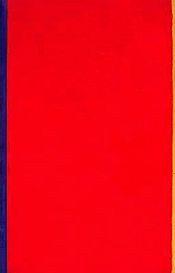
[barnett newman's who's afraid of red, yellow and blue, 1966 - not the painting mentioned below, since the tate are not generous when it comes to reproduction rights, though this is partly due to the parsimony of some original copyright holders - certain artists' estates for example - who can be vicious in their pursuit of copyright infringement; some won't even allow their paintings to be glimpsed in the background of phtographs and videos of other works]
while at the tate I spent some time with several abstract expressionist works that I have always loved: barnett newman’s adam and eve, pollock’s summertime: number 9a, franz kline’s meryon... and it struck me for the first time that one of the functions of their size (like most abstract expressionist pictures, these are all big paintings) is to persuade the viewer that they really are art.
i guess context-dependent art began - in the public imagination at least - with marcel duchamps' fountain (1917)
.jpg)
it's hard to think of works of art before this which needed to be displayed reverentially in a gallery or church or other spiritual building for them to be recognised as art. if you found art on a trash-heap you knew it was art.
we have become so used to abstract expressionist paintings being so obviously and unquestionably 'art' (indeed rather earnest and traditional art when compared to the work of these artists' upstart juniors: jasper johns, frank stella, andy warhol...) that we don't notice how easily they could be mistaken for stuff that isn't art. a pollock could be an accident on a studio floor. a barnett newman could be a carpet design. a franz kline could be the first few exuberant strokes of a housepainter starting to cover a wall. banal, maybe, but true. like the urinal they are context-dependent, if not to the same extent. but they solve the problem by being enormous. they carry their own space with them. they overwhelm you. they fill your field of view. they say say look at me and admire.
coincidentally a couple of days later i was watching john logan's play red at the donmar warehouse. it's about mark rothko who, among other things, is grappling with precisely this problem. he is working on his murals for the seagram building in new york, a commission he finally rejects. we don't know precisely why (in real life, at least) but it's fairly clear that however great the power of his paintings to create their own reverential space, they would rapidly have become wallpaper when they were hung above the wealthy, self-satisfied diners in the four seasons restaurant.